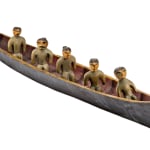-
Artworks
UNIDENTIFIED ARTIST, NUU-CHAH-NULTH OR COAST SALISH
Large Model Canoe with Figures, late 19th centurywood, pigment, and metal, 4 x 57.25 x 4.25 in (10.2 x 145.4 x 10.8 cm)
unsigned.
LOT 21
ESTIMATE: $4,000 — $6,000Further images
-
(View a larger image of thumbnail 1
)

-
(View a larger image of thumbnail 2
)

-
(View a larger image of thumbnail 3
)

-
(View a larger image of thumbnail 4
)

-
(View a larger image of thumbnail 5
)

-
(View a larger image of thumbnail 6
)

-
(View a larger image of thumbnail 7
)

-
(View a larger image of thumbnail 8
)

Model canoes had limited presence in Northwest Coast cultures, but can be found in the oldest European collections and have even been recovered archaeologically, dating back 300 years. These may...Model canoes had limited presence in Northwest Coast cultures, but can be found in the oldest European collections and have even been recovered archaeologically, dating back 300 years. These may have been made for children, but other cultural purposes are also possible. Model canoes, like model totem poles, became widely popular in the mid to late nineteenth century, and canoe models representing all the historical types survive from that time, and continue to be made by contemporary artists today.
Canoe races have probably taken place on the coast throughout history, but organized competitive races became widespread around 1900. On the southern coast, primarily among the Coast Salish, canoe racing reached throughout their region of influence, from southern British Columbia to western Washington State. Nearly every Native community in the area supports a fleet of racing canoes, pulled by crews both male and female. The smallest racing canoes are singles, about twelve feet long. Races are held throughout the summer in a wide range of traditional locations.
In the nineteenth century, the Nuu-chah-nulth canoe style, with a greater reputation for seaworthiness established on the ocean, came to replace the indigenous Salish canoe in the Puget Sound / Salish Sea region, the dominating presence in historical photos of the area. Similarly, when purpose-built racing canoes were developed, fifty-five feet long, little more than two feet wide, and crewed by eleven ‘pullers’, they were most often embellished with bow and stern elements from the Nuu-chah-nulth style canoe. This model, designed for only six pullers, in full size would be about forty feet long, and very fast.
Steven C. Brown
Literature: For three early-mid 19th century canoe models (Nuu-chah-nulth or Makah) see Steven C. Brown, Native Visions: Evolution in Northwest Coast Art from the Eighteenth through the Twentieth Century (Seattle: Seattle Art Museum / Vancouver: Douglas & McIntyre, 1998), pp. 64-65; and a Makah example c. 1890 (ibid.), p. 137.
Provenance
A Canadian Collection. -
(View a larger image of thumbnail 1
)
Join our mailing list
* denotes required fields
We will process the personal data you have supplied in accordance with our privacy policy (available on request). You can unsubscribe or change your preferences at any time by clicking the link in our emails.








